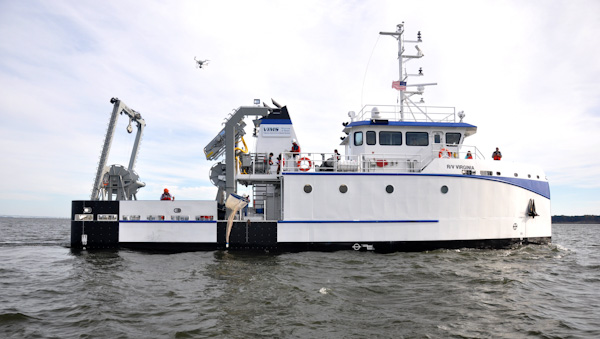The 93'x28'x12.7' research vessel Virginia successfully completed sea trials and is currently transiting to its home port in Virginia.
Matane, Quebec, Canada-based Meridien Maritime Reparation built the research vessel Virginia for the Virginia Institute of Marine Science, Gloucester Point, Va.
Designed by JMS Naval Architects, Mystic, Conn., the vessel operates as an uninspected research vessel with an ABS Loadline. The design offers flexibility in science outfitting allowing for high utilization and affordable operating day rates. The vessel is easily adaptable to evolving scientific research areas such as offshore oil and gas exploration surveys, wind energy development surveys, environmental impact studies, and the servicing of ocean observing systems.
The primary mission of the Institute’s fleet is to provide inshore and offshore work platforms for the support of fisheries related oceanographic research projects. The new vessel, which has a 9'6" draft, will be capable of conducting fisheries assessments of greater capacity, in deeper waters and with a larger science complement than the previous vessel used by the institute.
The Virginia will support the institution’s fisheries research projects and greatly expand VIMS’ capability to perform general oceanographic research in the Chesapeake Bay as well as mid-Atlantic coastal waters. Interest in the new research vessel is already growing rapidly as next season is almost fully booked with science cruises.
Main propulsion is provided by a pair of 660-hp Tier 3 Cummins QSK 19M engines coupled to Finnoy 2G27-42FK two–in/one-out marine gears driving Finnoy 5-bladed, 1.95 meter diameter controllable pitch propellers. The props turn inside of a Rice thrust nozzle with triple rice rudders for steering. The unique arrangement provides the capability to operate the vessel efficiently on a single propulsion engine when on station or during slow speed transits. This feature is designed to reduce overall engine hours and improve fuel efficiency, minimizing its environmental footprint. The gearbox also powers a robust hydraulic system via two independently clutched PTOs, to support the suite of deepwater trawl winches and bowthruster. The electrical system is comprised of a pair of 99 kW Kohler 99EOZCJ generators which provide redundant capability or can be run in parallel during peak power demands. LED lighting will reduce both power consumption and heat emitted into the accommodation spaces.
A Veth VCG-750 pump jet omnidirectional flush mounted grid bowthruster in combination with the controllable pitch propeller and triple rudders provide excellent maneuverability. The vessel’s capabilities are further enhanced by a state-of-the-art Beier Radio IVCS 4000 dynamic positioning system. The dynamic positioning system has been demonstrated to provide excellent station keeping.
The Virginia makes use of a beam of 28', relatively low vertical center of gravity and underwater hull form attributes including the propeller nozzle, triple rudders, twin skegs mounted outboard and the single chine hull form to provide high initial stability and significant roll dampening to impart stability characteristics of a larger vessel. Early indications are that the vessel is a very stable work platform in both head and beam seas. Measures were also taken to ensure an acoustically acceptable working environment onboard the vessel for scientists and crew. The propulsion engines and generators and their respective exhaust systems are resiliently mounted and acoustic material treatments throughout the vessel minimize noise and vibration levels.
Oceanographic outfitting includes large wet and dry labs which have been designed for maximum flexibility to accommodate the many types of science that the vessel is expected to conduct. The 1,000 sq. ft. main working deck allows for a 20 long ton science payload and provides a significant working platform for conducting fishing operations, over-the-side sampling and coring activities. There is also ample room and services to install a 20' science van for specialized science missions. The new research vessel takes advantage of the latest technology through transducer fairings prepared to receive an extensive array of acoustic instrumentation for the gathering and processing of data in support of fisheries research, oceanography, and geophysical sciences. A full size server rack, with dedicated closed loop cooling and UPS power supply has been fitted to the dry lab in anticipation of the requirements of scientific users.
The aft deck is fitted with a stern A-Frame with an 8,000 lb. safe working load for over the stern lifting operations and a side mounted J-Frame with an 4,000 lb. safe working load for conducting CTD operations. Hawboldt Industries provided the oceanographic weight handling and fishing gear including the trawl net reels, a pair of trawl winches with 4,000 lb. linear pull with 355 fathoms of 3/8" wire to support bottom trawl surveys, an electric CTD (conductivity, temperature, and depth) winch with 2,000 m of 0.322" wire and a knuckle boom deck crane with a 2,240 lbs. capacity at a 33' reach. The lifting equipment, excluding the CTD winch, is powered by a redundant electro hydraulic HPU.




